By Rhett Allain
(Today’s post is in honour of International Star Wars Day: May the 4th be with you!)
Recently, the US government declined an online petition to build an actual Death Star. (The answer is brilliant and well worth reading! – Ed.) Yes, it’s a shocking decision in many ways, but let’s pretend for a moment that someone did want to build a Death Star. Could you use ESA’s Automated Transfer Vehicle to do this? Well, of course you could – but what would that be like?
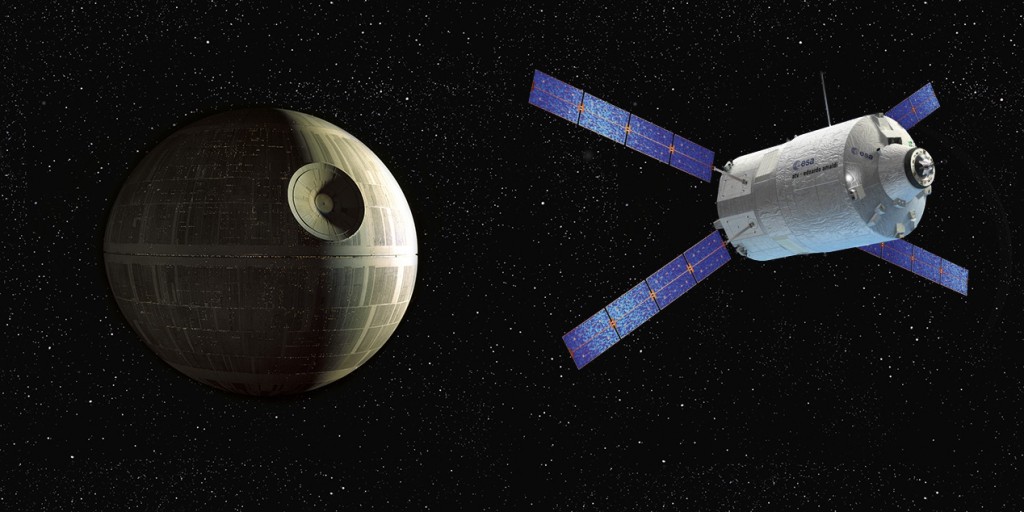
ATV nearing the Death Star! Image credits – Death Star: Lucasfilm Ltd. © & TM. All Rights Reserved. ATV: ESA
Editor’s note: In addition to having a knack for science communication, Rhett Allain is Associate Professor of Physics at Southeastern Louisiana University. He writes regularly for Wired’s Dot Physics blog and is a bit of a physics fanatic who spends more time than many pondering how daily life intersects with science. With the recently announced development of ATV in cooperation with NASA for Orion, we’re delighted to feature a few posts from the far side of the Atlantic. Enjoy!
If you want to estimate how many ATV launches it would take to build or supply the Death Star, you first need to know something about a Death Star. I could just make some wild estimates about the Death Star, but I won’t. Instead I will look at two interesting estimations.
Estimates about a Death Star
The first is from Centives, an economics blog. They start their estimate in the same way that I would. They assumed the Death Star is kind of like an aircraft carrier – that kind of makes sense. With this assumption, they get a mass of 1018 kg of material needed for their estimate of a Death Star with a diameter of 140 km. Just a quick point (or reminder): There were two Death Stars. According to Wookieepedia, the first Death Star had a diameter of 160 km. The second was even bigger. I will consider building the smaller Death Star (but I would NOT place the exhaust port at a location where it’s so easy to deliver a proton torpedo – that would just be foolish).
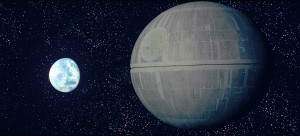
Death Star bigger than 140km? Could be – it’s all a matter of perspective! Image credit: Lucasfilm Ltd. © & TM. All Rights Reserved.
Ok, but there is another estimate of the mass of the Death Star. The popular site io9 figures that the Death Star wouldn’t even be built of something like steel. Modern warships are built of steel since they have to be rigid enough to withstand waves and torpedos and things like that. The Death Star would be in space, so it wouldn’t need to be as rigid to prevent collapse due to water pressure. Also, they would possibly have some type of force fields for shields to protect from enemy fire. Perhaps a Death Star would use steel, but only on the exterior surface. The interior could constructed from much lower-density material like something similar to carbon fibre.
Let’s go with the following estimate for the mass of the Death Star: If it has a 10-cm-thick outer shell of steel, this would be a mass of about 6 x 1013 kg.
Now, what about the interior?
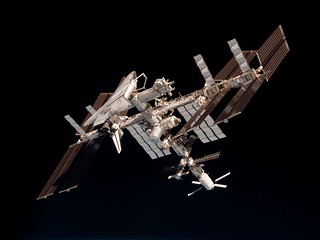 Lets say that the rest of the interior of the Death Star is somewhat similar to the density of the International Space Station. That makes sense, right? The ISS has a pressurized volume of 837 m3 and a mass of 4.5 x 105 kg. This would give an approximate density of about 550 kg/m3. (Of course this is wrong since there is more mass than just that inside the pressurized part of the ISS, but at least it’s start.) If I use this same density for the interior of the Death Star, I get a mass of 1018 kg. This pretty much agrees with the Centives estimation above (note that the mass of the steel shell is negligible compared to the interior).
Lets say that the rest of the interior of the Death Star is somewhat similar to the density of the International Space Station. That makes sense, right? The ISS has a pressurized volume of 837 m3 and a mass of 4.5 x 105 kg. This would give an approximate density of about 550 kg/m3. (Of course this is wrong since there is more mass than just that inside the pressurized part of the ISS, but at least it’s start.) If I use this same density for the interior of the Death Star, I get a mass of 1018 kg. This pretty much agrees with the Centives estimation above (note that the mass of the steel shell is negligible compared to the interior).
Using the ATV for building supplies
Now what about the ATV? The current ATV, ATV Albert Einstein, is carrying a payload of 7,200 kg. How many ATV launches would therefore be required to bring all the material needed into orbit (assuming the Death Star would be built in the same orbit as the ISS)?
Ok. That is clearly more ATV launches than anyone would like to deal with. If one ATV mission was launched every month (very ambitious) that would take 1013 years. Just for comparison, the Earth is under 5 billion years old. Our Sun will only last maybe another 5 billion years. So 1013 years is just a little too long for this Death Star to be built. By the time it was finished, our star would be dead. Get it? ‘Death’ Star? Yes, that was a bad joke…
Let’s look at this from the other end. Suppose we want the Death Star finished in 10 years. If we still used the ATV, we would still need the same number of launches. How frequent would these launches be if they were evenly spaced out?
 It’s difficult to picture that many in a year. If I convert this number, I get 4 launches/second. Clearly, the current ATV infrastructure can’t handle this turn-around time. What if the whole human race works together to ramp up the ATV launching process? Maybe each ATV can relaunch with a two-week turn-around time. During this two-week period, there would have to be 4.8 million different ATVs. That’s quite a large number of vehicles.
It’s difficult to picture that many in a year. If I convert this number, I get 4 launches/second. Clearly, the current ATV infrastructure can’t handle this turn-around time. What if the whole human race works together to ramp up the ATV launching process? Maybe each ATV can relaunch with a two-week turn-around time. During this two-week period, there would have to be 4.8 million different ATVs. That’s quite a large number of vehicles.
What about supplying an existing Death Star?
Really, the primary role of the ATV is to bring supplies to the ISS. What if the Death Star was already in orbit; how many ATVs would be needed to service it? Prepare yourself for some more wild estimates…
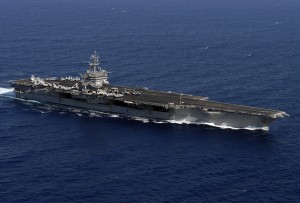
The aircraft carrier USS Enterprise (CVN 65) cruises underway in the Atlantic Ocean with her embarked Carrier Air Wing One (CVW-1).
First, I need to get a value for the number of crew on the Death Star. What if the Death Star has a similar crew-volume-density as a Nimitz-class aircraft carrier? Why would that be the case? Why not? According to the US Navy, a Nimitz-class carrier has a crew of over 6,000 people with a volume of about 2 million cubic meters.
This gives a crew density around 0.003 crew per cubic meter. With this same density, the Death Star would have a complement of 6 x 1012 people. That is crazy since there are only 7 billion people on Earth.
We are just going to have to a bit reasonable with this crew estimate. There could possibly be large portions of the Death Star that just aren’t used at the same level of crew density as an aircraft carrier.
I know this feels like cheating, but I am just going to say there are 1 million people on the Death Star.
So, how many ATV missions would you need for a space station with 1 million people? The ISS gets about 1 ATV supply visit every 6 months for full crew of 6 astronauts. That would mean about 1 ATV per month per astronaut. (In fact, ATVs have been visiting the ISS about once per year, but Rhett’s estimation is pretty close – Ed.)
If I use this same ATV supply rate for the Death Star, it would be:

Of course, a station the size of small moon might be able to produce many of its own resources (We expect so! See A Greenhouse in Space – Ed). There is probably a greenhouse, a bakery and probably even a candlestick maker. Maybe they just need mail and shipments from their online purchases delivered via the ATV! 🙂
Pre-emptive comments
Let me just point out something obvious: The Death Star is not real. I know that and you know that. Of course, that doesn’t stop us from having some fun with these calculations!
PS: We’re not certain that ATV carries, in fact, any online deliveries ordered by the crew, but you can read our Big Cargo Post for ATV-3 detailing everything it did carry. We’ll post an update on ATV-4 cargo in the coming days – Ed.


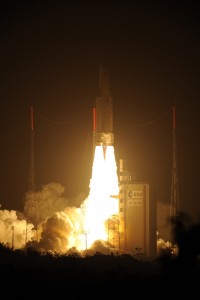
 Automated Transfer Vehicle page
Automated Transfer Vehicle page ATV blog archive
ATV blog archive
Discussion: 8 comments
„The ISS gets about 1 ATV supply visit every 6 months for full crew of 6 astronauts. That would mean about 1 ATV per month per astronaut.“
Wait, isn’t it 1 ATV for 36 astronauts every month?
yes
What would happen to the ozone layer with all these rockets launching every fortnight?
Also, could the ATV ramp up further to compensate for all the air leaking from the Death Star structure?
A death star maybe not but a military station is a probable yes. The obvious is that this can be used bot against earth enemies but also against rogue and dangerous meteorites. Also such a station could be used as a second ISS Station taking part in scientific experiments as well.
This might be beyond Earth’s current capabilities, but in the Star Wars Universe, we were dealing with the equivalent of a military dictatorship, with the resources of not one, but hundreds of planetary systems at its disposal.
Not only that, but many of those resources would have been diverted from civilian interests and pursuits to speed up Death Star construction (similar to rationing and manpower provisions undertaken by many allied nations during World War II at best, North Korea at worst).
I’m sure there would have been some form of conscription and possibly slave labour used (using ethnic minorities and political enemies, with the added benefit of saving resources, like food, for the latter) and you can see why and how two (OK, one and three quarter) Death Stars were constructed in quick time.
Thank goodness this is beyond Earth’s capabilities…!
It’s funny how some people are getting all philosophical about all this when we haven’t even colonised Mars or started asteroid mining… (both of which would cost pocket change [in comparison] and should happen within the next three-to-four years)
The American aircraft carriers are behind the curve at the moment, so what I’m trying to get at is you should base your calculation when it comes to crewing on the Queen Elizabeth class of the British super carriers were most of the systems are automated and are very advanced.
What if I only wanted the planet destroying death ray? How much energy would that require each time it was fired?